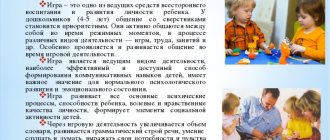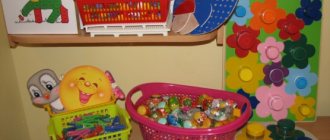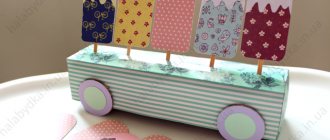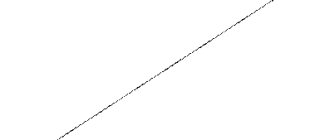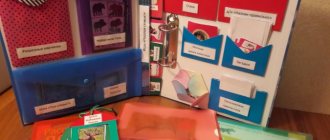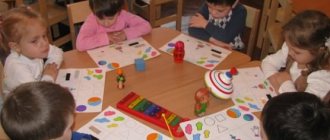"Circles of Llull" are a set of interconnected circles or rings in the shape of a pyramid. The creator of this complex of developments is the French monk Raymond Llull. The history of the game's creation began with work on the development of speech functions and logical thinking.
Currently, “Pacification Circles” are actively used by teachers and speech therapists in kindergartens. Thanks to its simple design and wide functionality, this product is understandable and easy to use, and is indispensable in the work of teachers.
How to use Lull circles?
Circles of Llull - what are they? This is a kind of pyramid with pictures, words or numbers. The arrow is located above the circles. All rings are movable and can be rotated in both directions. The rings are divided into several sectors. As the circles rotate, the arrow highlights certain sectors at each level. Sectors can contain pictures, riddles and entire sentences.
The player asks a question and spins the toy. The resulting combination can be interpreted as an answer to the question, and imagination and logic are associated with decoding.
Modern “circles” are divided by topic. Together with your children you can study “Fruits and Vegetables”, “Animals”, “Clothing” and so on. “Circles of Calm” are ideal for introducing a child to the outside world. In a playful way, preschoolers learn new words, their meanings and functions.
“Quiet Circles” are especially recommended for the following activities in a preschool educational institution:
- Familiarization with surrounding objects;
- Development of coherent speech;
- Knowledge of mathematics;
- Development of thought;
- Ability to establish logical connections between objects;
- Comfortable socialization and communication with people, etc.
You can create “Lulle circles” with your own hands. The topic is selected at the discretion of the teacher for a particular lesson.
TRIZ technologies in kindergarten Circles of Lullia.
TRIZ technologies in kindergarten Circles of Lull.
One of the effective pedagogical technologies for developing children's creative abilities is TRIZ - Theory of Inventive Problem Solving.
The purpose of using TRIZ in kindergarten is to develop, on the one hand, such mental qualities as flexibility, mobility, coherence, and on the other hand, research, the desire for novelty, language development and creative imagination.
I bring to your attention a game system of tasks and exercises based on the invention of Raymond Llull - “Circles of Calm”. Which is directly related to TRIZ technology. The invention received its name in honor of the name of its creator. In the 13th century, a French monk created a logic machine in the form of paper circles.
In my work, I use Llull circles as a play technique aimed at enriching a child’s vocabulary, developing cognitive activity, and expanding ideas about objects. They are effectively used in pedagogy to develop the linguistic, intellectual and creative abilities of children.
Lull circles are presented to preschoolers in the form of wonderful rings or mysterious circles. To work with children 3-4 years old, it is recommended to take only two circles of different diameters, 4 sectors in each.
When working with children 5-6 years old, two or three circles are used (4-6 sectors in each).
What else to read: Didactic games for children: development of speech, sensory, physical development. Do-it-yourself card index with goals
Children of the 7th year of life cope with a sufficient number of tasks that use four circles of 8 sectors each.
It is recommended to play games outside of class in the form of play exercises (individually or with subgroups of children). Pictures on a specific topic are attached to the sectors.
The game should consist of two parts:
1) clarification of existing knowledge in certain areas (real task);
2) exercises to develop imagination (fantastic task).
Technological chain of the game:
1. In all areas of the circle, images or signs indicate any objects.
2. The activity is configured.
3. The circles are spinning, the children look at what images are on the circles under the arrow and name them.
4. Create a story based on the fantastic transformation.
The discs are suitable for all ages. For my older children I use games like “From what?”, “Professions”, “More or less”.
But the game is also suitable for young and middle-aged people. I have prepared games such as “Whose Tail?”, “Opposites”
, “Whose shadow is this?”, “Take a pair.”
Games with “Circles of Calm” can be divided into three types:
1. Matching games:
“Name the puppy.”
2. You play with an element of randomness in the placement of rings:
D / I “Zoom out, increase” D / I
3. Games to develop creative imagination:
D/I “Whose puppy?” D/E “seasons”
You can create this guide yourself. I bring to your attention step-by-step instructions.
For manufacturing you will need: a sheet of plywood 4 mm thick, chipboard spacers (for support), a threaded rod, washers, nuts.
Draw three circles with a diameter of 40, 20 and 10 cm and cut out the circles with a jigsaw.
Drill a hole in the center of each circle. I spray painted it. We divide the structure we have made into 8 parts - sectors. We attach a piece of linden to each part, after which there is a long and painstaking process of selecting images on which the linden is also attached.
The kids participated in cutting and pasting pictures for small Lilluj clubs.”
Therefore, Llull circles can be used in any area: to consolidate knowledge of numbers and the ability to count objects (on one ring there is a group of objects, on the other there is a corresponding number), knowledge of geometric figures (connect an object of a certain shape with a standard, for the development of phonemic hearing (link an image with a letter) , indicating the first sound in a word, and on the third ring you can depict a syllabic analysis scheme and count the syllables in words).
The uses for this technique are endless. Our teachers are actively studying it, the children really like it, and we also recommend it for you in your work.
Thank you for your attention.
Developmental manual for speech development “Rings of Lull”
1. Photo of a developmental manual.
2. Description of the algorithm for producing the manual.
To make a manual, you need to take: two rectangular pieces of any solid material, for example: plexiglass, plywood, thick cardboard, plastic, a width equal to the diameter of your rings, and a length 2-4 cm less than two diameters of the rings. On the bottom plate, in the places of the supposed centers of the rings, it is necessary to strengthen the pins. Build a small side around the perimeter, and attach legs or hinges to the bottom side. It is necessary to cut out a window in the upper rectangle so that the combined pictures are visible. If the game will only stand on the table, then the lid can not be attached, but simply placed on the sides of the base. If the manual can be hung on the wall, the cover must be secured.
For free and convenient rotation of the rings, it is proposed to use a base in the form of old gramophone records. It is convenient to rotate the circles by the protrusions, which are formed as a result of the fact that the width of the aid is 2-4 cm less than two diameters of the plates.
3. Problems that this manual helps solve.
- develop phonemic processes;
- clarify and activate vocabulary;
- improve the syllabic structure of words;
- automate speech sounds;
- form the structure of sentences;
- improve the development of coherent speech.
This game guide can be used to reinforce articulation exercises, correct the sound side of speech, and for the development of lexical and grammatical categories and coherent speech.
4. Option for using the manual.
Games that improve the sound aspect of speech and literacy: “Sound Circles.” “Zvukariki”, “Where is the sound hidden?”
Purpose of the games:
- improving sound analysis skills
- literacy training
- expansion and activation of the dictionary
Description: Games are played in pairs or with a subgroup of children. On the 1st circle there are pictures with the image of “sound” (pump-S, mosquito-Z, bee-Zh, snake-Sh..), on the 2nd circle there is a picture and a sound diagram. According to the rules of the game, you need to match the picture “sound” with a picture with a diagram and determine the position of the sound in the word. You can replace pictures with sound patterns with letters and call the sound that lives in its apartment a letter. The degree of difficulty of tasks should increase gradually. Children accompany all their actions with speech, consolidating the skills of sound analysis and acquired knowledge of literacy.
Games for the formation of lexical and grammatical categories: “Whose, whose, whose?”, “Form a word”, “One is many”, “Name it”, “Count it”
Purpose of the games:
- improving the lexical and grammatical structure of speech
- strengthening the skills of word formation and inflection.
- expansion and activation of the dictionary
- development of coherent speech
Description: The organization and conditions of the games are the same. On the 1st circle there is a picture of an animal or bird, on the 2nd circle there are parts of its body (tail, paws, ears, nose, wings...) or cubs, or a habitat, or several animals and birds. Children, spinning circles, select a pair, consolidating knowledge about the animal world and lexical and grammatical categories that they met in a lesson with a speech therapist. These game exercises reinforce the formation of a coherent independent statement.
Games that improve the development of articulatory motor skills: “Tongue exercises”, “Look and show”
Purpose of the games:
- improving children's articulation abilities
- development of visual gnosis and constructive praxis
- developing cooperation and independence skills
Description: The game is played in pairs or two subgroups of children. Take circles 1 with a picture of an articulation exercise, 2 with pictures corresponding to an articulation exercise (fungus, swing, fence, watch, cup). A picture is installed in one of the windows, the pair of which is selected by scrolling the second ring. In these games, one picture of circle 1 must correspond to a picture of circle 2. Children, by finding and selecting pictures, simultaneously consolidate their skills in performing articulation exercises, name articulation exercises and consolidate the poems learned for this exercise.
Authors: Daniliva Olga Ivanovna, teacher-speech therapist; Shumilina Evgenia Nikolaevna, teacher; MBDOU d/s general developmental type No. 53, Volzhsky, Volgograd region, Russia.
The article is published in the author's edition
Examples of games with “Lulli circles”
"Animals and Cubs"
Animals are depicted on the upper ring, and their young are depicted on the large one. The teacher names any animal. By turning the circles, the child must find a child named animal. For example, a kitten is paired with a cat, and a puppy is paired with a dog. The player’s task is to find each child his mother and vice versa.
"Fairy Tales and Heroes"
The rings depict heroes of famous fairy tales and objects belonging to them. The teacher names the hero, and the child looks for what the character uses in the story. For example, Baba Yaga is a stupa or a broom, Pinocchio is a key, etc. The children's task is to find their own thing for each hero.
What else to read: Modeling with children 3-4 years old. Lesson notes (3 pages)
"Count"
The rings represent objects and numbers. How to play? The teacher rotates the arrow and names the released image. The child’s task is to count how many objects are in the picture and name the correct number. For example, two balls, four books, etc.
"Sochetayka"
The rings depict random objects: trees, colors, words. The teacher spins the arrow. The children’s task is to tell how to connect the fallen images. For example, you will get a pair of wooden ones - red. This means that the leaves change and turn red in the fall. Do the same with the following combinations.
Lull's Circles is a simple educational game that has a positive effect on children's brain activity. In a playful way, the baby not only stimulates thinking, but also spends pleasant and funny moments with friends.
Series of educational games “Magic Circle”
Irina Pogorelova
Series of educational games “Magic Circle”
Good morning, dear colleagues!
I would like to share with you ideas for creating and using five original didactic games from the “Magic Circle” series in working with children.
The basis of all games are one or two circles of different diameters made of thick cardboard, covered with colored self-adhesive paper and fastened in the middle so that the upper circle rotates freely.
1. Educational game “Where is my shadow?”
We encounter shadows cast by various objects quite often. In this case, shadows, in fact, are a repetition of the objects that cast them. For this reason, it is absolutely easy to navigate and determine where whose shadow is.
Purpose of the game: development of attentiveness, more accurate perception of the shape of surrounding objects, cognitive activity, and thinking.
Progress of the game: We insert a color picture with the image of a funny little man into the transparent pocket on the upper circle and invite the child to rotate the upper circle until the image of the little man coincides with his shadow on the lower circle, etc. First, children must indicate their option, and then justify your opinion about the choice made.
2. The didactic game “Find the owner of the helmet” is similar to the game “Where is my shadow?”
We insert an image of a helmet into the transparent pocket on the top circle, and the child, by rotating the top circle, must determine which of the heroes depicted on the bottom circle it belongs to.
1. Didactic game “Find an object of the same shape”
Purpose of the game: To teach children to distinguish and name geometric shapes - square, oval, circle, rectangle and triangle, to learn to correlate sensory standards with objects in the surrounding world. Develop mental operations: analysis and comparison. Enrich children's vocabulary.
How to play: To play you will need cards with images of geometric shapes and, of course, a “Magic Circle” on the bottom of which pictures with images of various objects are glued using double-sided tape. By rotating the circle, the child needs to find an object similar to a geometric figure, a card with which it is inserted into a transparent pocket. After completing the task, children justify their choice.
Cards for these games are stored on the back of the game in securely fastened, resealable envelopes.
4. Didactic game “Bad and good deeds”
The difference between this game and previous games is that there is no transparent pocket on the top circle. Instead, there are oval cutouts on opposite sides of the top circle. On the bottom circle, colored plot pictures are attached using double-sided tape, indicating modally opposite modes of behavior.
Purpose of the game: Social and moral development of children through the formation of ideas about methods of socially acceptable behavior.
Objectives: develop the ability to differentiate patterns of positive and negative behavior in society; develop observation, intelligence, speed of thinking; develop the ability to establish cause and effect relationships; develop speech skills; fine motor skills.
Progress of the game: Children must turn the circle so as to find for each behavior model an opposite model similar to it, justifying their decision. For example: “If teasing kids is bad, then playing with them and sharing toys is good.”
5. Didactic game “Find the same emotion”
This game consists of one circle with images of the basic emotions of boys and girls and arrows attached in the middle.
Purpose of the game: development of the emotional sphere.
Objectives: To teach children to recognize various emotional states, express them freely, and depict them using facial expressions, pantomimes and vocal emotions.
Develop the ability to identify emotions from a picture, compare them, develop observation, imagination, expressiveness of movements and speech.
Game rules.
Option 1: “Depict the same emotion.” Invite children to carefully look at pictures of children, draw their attention to the variety of external signs of the manifestation of emotions, their differences and similarities. Offer to depict this emotion on your face by indicating it by connecting two arrows together. Offer to fantasize about why the child is in such a mood.
Option 2: “Recognize the emotion.” The game uses, in addition to the “Magic Circle”, which is in the child’s possession, cards describing the external signs of the manifestation of emotions (facial expressions). The adult reads cards describing facial expressions, and the child must find such an emotion using the arrows on the Magic Circle.
Option 3: “Find the opposite emotion in a boy (girl).”
Option 4: “Find the same emotion in a boy (girl).”
We all want our children to be smart, inquisitive, quick-witted - in short, smart. The world into which a child comes is rich and diverse. To live in it, the baby needs to master a large flow of information. He finds the answer to many questions by going through trial and error, comprehending patterns. Using these games in individual work, I try to help children get joy from completing tasks, believe in themselves, better assimilate initial ideas about the surrounding reality, develop verbal communication skills and the ability to correctly express their thoughts.
